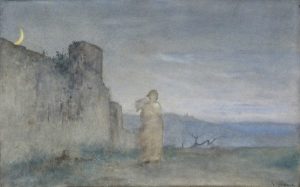Biography

CABIANCA Vincenzo, painter (Verona 1827 – Rome 1902). Born in modest origins, he was soon attracted to painting, so much so that he left the seminary to attend the Cignaroli Academy in Verona under the guidance of G. Caliari and, subsequently, the Academy of Fine Arts in Venice, where he attended the courses of Lipparini and Grigoletti.
Interested in the painting of Domenico Induco and Stefano Ussi, he initially lingers on this genre, devoting himself to historical subjects in costume, then much in vogue, set mostly in interiors crowded with figures.
After moving to Florence he came into contact with Telemaco Signorini and Odoardo Borrani, converting to the poetics of the maquis in 1855 with L’uva matta, and above all with the splendid Woman with a pig against the sun that would have greatly impressed Fattori for his lighting research.
Since he became a friend of C. Banti, he went with him to paint in the Florentine countryside and then, accompanied by Signorini, to Lerici and La Spezia, places all portrayed in admirable tablets.
In 1861, always in the company of Banti and Signorini, he went to Paris, where he deepened his knowledge of A. G. Dècamps, whose influence is noticeable in the violent chiaroscuro contrasts of subsequent works.
Until 1870, during the period dedicated to the scrub, the “solar effects” that we find in his paintings are remarkable, tense as he was in the conquest of full light effects and violent contrasts.
Permanently settled in Rome, with a studio in via Margutta 33, he became a regular friend of Nino Costa, with whom he deepened his research on the real “en plein air”, joining the In Arte Libertas (1885).
Called by Ettore Roesler Franz and Nazareno Cipriani among the founders of the Watercolorists, he exhibited the evening and the snow in Venice at the 1881 exhibition, valued at the time as much as 2,000 lire.
He took part in several other editions of the Watercolors exhibition, despite a bad paralysis that struck him in 1893, forcing him to thin out his business over time.